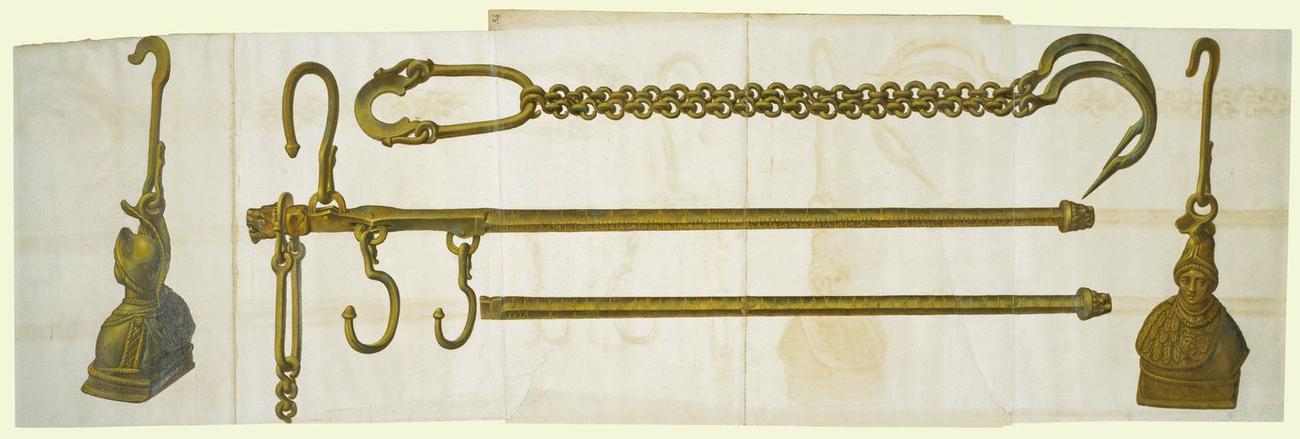A Roman steelyard balance (statera) c.1630-49
Watercolour and bodycolour over black chalk and pen and ink | 40.8 x 126 cm (sheet of paper) | RCIN 911186
-
A drawing of a Roman bronze steelyard balance, drawn in actual size, with a counterweight in the shape of a bust of Minerva.
This drawing formed part of Cassiano dal Pozzo’s ‘paper museum’, and demonstrates Cassiano’s interest in Roman daily life. Ancient systems of weight and measure were a particular fascination for seventeenth-century antiquarians. The drawing depicts, at actual size and in several views, a bronze statera or steelyard balance for weighing goods, with three alternative fulcra and corresponding scales, and a bust of Minerva as a counterweight.
This drawing comes from the collection of Cassiano dal Pozzo (1588-1657), one of the great figures of seventeenth-century Rome. His collection was notable not for its magnificence (though he was Poussin’s most important patron) but for its range. Lacking the financial resources of the princes and cardinals of the age - among them his employer, Cardinal Francesco Barberini - Cassiano instead commissioned and collected many thousands of drawings and prints to form a visual encyclopedia or ‘Paper Museum’, principally of antiquities, architecture and natural history.
Over several decades Cassiano engaged artists to make drawings of sarcophagi and other sculpture, archaeological remains, ancient buildings and inscriptions. Many of these were done directly from the objects, but a number were copied from sixteenth-century sources. This drawing demonstrates the interest of seventeenth-century antiquarians in Roman daily life (of which ancient systems of weight and measure were a particular fascination). It depicts, at actual size, a bronze statera or steelyard balance for weighing large quantities of meat, sacks of produce and so on. The object to be weighed was suspended from the hooks shown along the top of the drawing and hung from the left end of the balance. One of three different fulcra was chosen, depending on the weight of the object; the counterweight, in the form of a bust of Minerva, was moved down the arm of the steelyard to achieve a balance. The weight of the object was then read off a scale marked on the relevant face of the arm. Because of the different fulcra, this apparatus allowed a wide range of weights to be measured quickly and accurately, and steelyards are still in use across the world. Many survive from antiquity, though - somewhat surprisingly - this particularly impressive example has not been identified.
While many of the drawings in the Paper Museum cannot be attributed to individual artists, a large group of elaborate sheets seem to be by Vincenzo Leonardi, who worked for Cassiano from at least 1621 until 1646. Most of these are of natural history subjects, and use a sophisticated layering of watercolour and bodycolour. Though the subject matter here is unusual for Leonardi, the style and technique of the drawing are his, and the sheet may be attributed to him with some confidence.
The drawing was the first illustration in Francis Haskell’s introduction to the first publication emanating from the Dal Pozzo Project, which aims to catalogue in over thirty volumes all of the surviving Paper Museum.
Catalogue entry adapted from The Art of Italy in the Royal Collection: Renaissance and Baroque, London, 2007Provenance
Purchased by George III
-
Creator(s)
Acquirer(s)
-
Medium and techniques
Watercolour and bodycolour over black chalk and pen and ink
Measurements
40.8 x 126 cm (sheet of paper)
Object type(s)
Other number(s)
RL 11186









